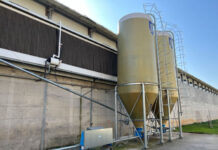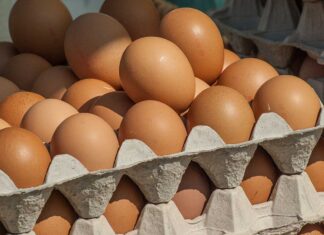
Bernard Tauzia, President of Synalaf (Syndicat National des Labels Avicoles de France or National Union of Poultry Labels of France), explains to Zootecnica International the main reasons of the success of the French poultry labels, particularly the Label Rouge quality recognition.
Philippe Caldier, Independent journalist – ph@caldier.fr
Could you present us the Synalaf in a few words ?
 Synalaf is an interprofessional organization created in 1967 which represents the regional organizations producing free-range poultry and eggs under official signs of identification of quality and origin: Label Rouge, IGP (Indication géographique protégée or Protected Geographical Indication) and Bio (organic farming). The whole production chain includes hatcheries, breeders, farmers, feed manufacturers, slaughterers and processors and egg packaging centers. In total, Synalaf represents nearly 90% of the meat poultry and egg sector under signs of identification of quality and origin. In addition, it is an integral part of the interprofessional organization for meat poultry, ANVOL, which also includes interprofessional committees for guinea fowl, turkey, roast duck and broiler chicken. It is considered that the French poultry sector represents 14,000 farmers and generates 100,000 direct jobs, including 34,000 on farms and 28,000 in slaughterhouses.
Synalaf is an interprofessional organization created in 1967 which represents the regional organizations producing free-range poultry and eggs under official signs of identification of quality and origin: Label Rouge, IGP (Indication géographique protégée or Protected Geographical Indication) and Bio (organic farming). The whole production chain includes hatcheries, breeders, farmers, feed manufacturers, slaughterers and processors and egg packaging centers. In total, Synalaf represents nearly 90% of the meat poultry and egg sector under signs of identification of quality and origin. In addition, it is an integral part of the interprofessional organization for meat poultry, ANVOL, which also includes interprofessional committees for guinea fowl, turkey, roast duck and broiler chicken. It is considered that the French poultry sector represents 14,000 farmers and generates 100,000 direct jobs, including 34,000 on farms and 28,000 in slaughterhouses.
What is official Label Rouge recognition?
Created in 1960 in France, on the initiative of traditional farm poultry producers and awarded for the first time in 1965, the Label Rouge is the only officially recognized quality sign that guarantees the superior quality of a product, compared to a “standard” product. It must meet strict taste and quality requirements. To ensure this, each stage of its production is rigorously controlled.
Only a Defense and Management Organization (ODG, Organisme de Défense et de Gestion), composed of all the partners involved in the development of the product, is authorized to apply for the Label Rouge. To get it, he must draw up specifications and a control plan in line with at least the common production conditions proposed by Synalaf members for the entire sector and validated by the National Institute of Origin and of quality (INAO). These specifications must precisely define the characteristics of the product, its production conditions and the controls to which it is subject. It is then the State, through the INAO, which awards the label to the ODG, after study and validation of its file. He can also, at any time, withdraw a label for recurring malfunction, non-compliance with specifications or for product quality juged insufficient (including organoleptic quality). The Label Rouge is therefore never acquired. The constant questioning of its attribution encourages professionals to constantly improve their practices and the quality of their products.
In addition, Label Rouge farm poultry is mostly identified by a protected geographical indication (PGI), registered and protected at European level, and there are currently about forty in poultry and eggs.
What main principles follow the production of Label Rouge poultry and eggs ?
Five main principles govern the production of Label Rouge poultry and eggs.
1. Respect for animal welfare and the environment
Raised on human-sized farms, Label Rouge meat poultry and laying hens live outdoors all day and throughout the year, as soon as their plumage is thick enough, in compliance with the highest European commitment to animal welfare. They have access to outdoor pens which include large grassy areas and many trees, shrubs, copses, hedges… Pens must have at least 2 m² of ground space per chicken in the “open-air” system, 4 m² in the “freedom” system and 5 m² per laying hen. Thus, the large area of these wooded pens contributes not only to the well-being of the animals, but also to that of the breeder, to the protection and preservation of the environment and to the landscape and territorial integration of the Label Rouge poultry farm. At the same time, many other practices are required in order to increase and guarantee animal welfare, such as, for example, a limited distance between the farm and the slaughterhouse (in Label Rouge poultry, this distance must be less than 100 km, i.e. less than three hours of transport).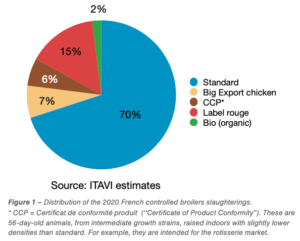
2. A choice of hardy breeds suitable for open-air production
Label Rouge poultry breeders contribute to maintaining the selection of hardy (rustic) breeds, selected for their slow growth and for their adaptation to outdoor farming. The hardiness of these poultry also makes them more resistant to diseases, which makes it possible to limit the use of drugs and in particular antibiotics. For these productions, the use of medicinal plants, essential oils, homeopathy or any other alternative product is preferred.
3. 100 % plant-based feed adapted to the needs of poultry
Poultry feed consists mainly of cereals (75% minimum for broiler chickens, for example) which provide energy and fibre, plant proteins (mainly soybean, rapeseed or sunflower cake, but also peas or beans), minerals and vitamins.
4. Longer rearing period and slow growth to ensure the optimum quality
The breeding time for chickens is a minimum of 81 days, more than twice as long as that of a standard chicken. Thus, for meat poultry, this principle allows the harmonious development of the skeleton and the muscles, guaranteeing firm and tasty meat. It thus offers organoleptic qualities superior to those of other poultry.
5. Strict controls at all stages of production and sensory tests
For the consumer, the reliability of the Label Rouge implies compliance with quality criteria at all stages of the production of free-range poultry and eggs, with three levels of controls: 1) in self-checks, by each company involved in Label Rouge production; 2) internally, by the ODG holder of the specifications; 3) externally, unexpectedly by an independent and impartial certifying body, accredited by the public authorities for each flock reared. The superior quality is verified by annual sensory analyses, carried out by a jury of experts and a panel of consumers.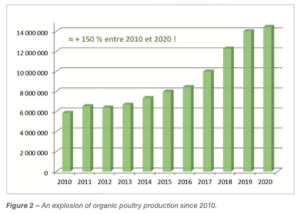
What are the key figures for French poultry production under Label Rouge?
The Label Rouge poultry sector brings together a set of complementary and specific professions:
– about 5,000 broiler and laying hen farmers;
– about 250 companies (hatcheries, feed manufacturers, slaughterhouses, cutting/processing workshops, egg packing centres);
– around twenty defense and management organizations (ODG) producing broiler poultry and/or Label Rouge eggs throughout France.
Over the past twenty years, the Label Rouge in poultry meat has grown significantly. As an illustration, chickens experienced strong growth (+5 million) and cuts continue to evolve favorably. However, we note a collapse in the volumes of guinea fowl (-5.5 million) and duck (-1 million). The year 2021 was a bit special because some production areas were strongly impacted by Avian Influenza and the volumes produced are therefore down slightly. It is estimated that Label Rouge poultry, all species combined, represent 12% of controlled slaughter of poultry in France and 15% of broilers.
And what about the consumption, distribution and export of Label Rouge poultry?
Label Rouge chicken is mainly eaten whole (ready-to-cook chicken, PAC-Prêt à cuire). However, in recent years, the cutting rate has grown to reach 35% (+10 points in 10 years). In 2020, Label Rouge chickens represented 48% of PAC and 10% of chicken cuts purchased by the French. These purchases are mainly made in supermarkets (Hyper + Super). 74% of purchases of PAC Label Rouge chickens and 62% of cut purchases were made in supermarkets, with an average price of PAC Label Rouge chicken in supermarkets of €5.80/kg (including promotions) in 2020.
Exports of Label Rouge poultry increased by 4% in 2020 compared to 2019 (mainly chicken). Belgium and Germany represent more than half of the volumes exported. Purchases of Label Rouge eggs are also on the rise: +8.4% in volume in 2020 compared to 2019. However, these figures should be put into perspective. Indeed, this sharp increase is explained by an egg market distorted by the Covid 19 crisis. During the various confinements, the consumption of eggs by households exploded. But in 2021, this expansion has reversed, and consumption has returned to levels similar to 2019.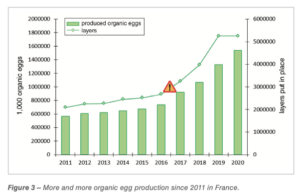
How important is organic production?
In 2020, the placement of organic poultry in the farms increased by 3% compared to 2019. In 2021, this trend seems to have continued despite consumption which has stabilized. It is estimated that in broilers, organic represents 2% of controlled slaughter. Regarding consumption, it is estimated that organic represents 14% of whole chickens purchased and 4% of cuts. Poultry exports are not regular: between 2018 and 2019 they decreased by 10% while between 2019 and 2020 they increased by 15%. Organic broiler exports represent three-quarters of total organic poultry exports and about 10% of national production. They are also mainly destined for Germany (+72%/2019) and Belgium (+8%/2019).
In 2020, the number of organic layers stabilized but the production of organic eggs continued to grow strongly. However, in 2021, the organic egg market has become more complex. Indeed, production has also increased while consumption is seriously tending to stabilize, or even decrease compared to 2020.
What were Synalaf’s main actions in 2021?
In 2021, Synalaf worked on many topics: economic indicators, improvement of common production conditions, European consultation on animal welfare, rising production costs, etc. It can also be noted that Synalaf has launched a new national information and promotion campaign entitled “Label and Poultry”. Its objective is to make alive the commitment of farmers on social networks. On the @label.et.la.volaille Facebook and Instagram accounts, farmers of Label Rouge free-range poultry and laying hens take the floor to share their passion for their profession, present their know-how in terms of animal welfare, respect for the environment and traceability. For us, it is a way to highlight this behind-the-scenes work and to promote these actors of excellence.
What are the hot topics and plans for 2022?
2022 will be synonymous with great challenges for Synalaf. Firstly, we will continue the work started to have the increases in production costs recognized by large retailers. New economic indicators will be created, for organic poultry or Label Rouge layers for example, and will supplement the existing indices for Label Rouge chicken and organic layers. They will more take in account the fluctuation of feed costs in these productions.
We will continue our promotional actions by obtaining a European communication program “Taste European excellence”. Built around 4 key values, animal welfare, know-how, sustainability and taste, it will be spread over 3 years. It will revitalize the consumption of Label Rouge poultry among young French adults and out-of-home catering. A second part will be export-oriented and will be aimed more specifically at German, Belgian, Dutch, Swiss and Danish catering and distribution professionals. In collaboration with ERPA, we will also work to preserve marketing standards in order to protect our free-range poultry. These few examples testify to the diversity of subjects and themes that Synalaf will take up to continue to defend the exceptional sectors that it represents.




